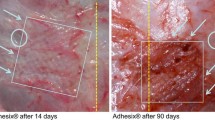Abstract
Background
Prosthetic reinforcement is now routine in the management of inguinal and incisional hernia, and it significantly reduces the risk of recurrence. After surgery, chronic pain is often attributed to the characteristics of the mesh and to the method of fixation in the wound, with a potential risk of nerve or muscle injuries.
Aim
To evaluate the properties of a new “self adhering” prosthesis in an experimental animal study.
Materials and methods
The self adhering prosthesis, a lightweight (40 mg/m2) polypropylene mesh coated with a synthetic glue on one side, was implanted laparoscopically in pigs. Removal of the prosthesis was performed at one day, one week and one month post operatively. A macroscopic and microscopic evaluation was performed. The results, using a quantitative score, were compared to those of a control group using the same polypropylene mesh without glue, but fixed by staples.
Results
The operative time was significantly lower in the self adhering group: 23 min (15–32) versus 31 min (21–40) (P = 0.01). The average time interval from the introduction of the mesh into the preperitoneal space until the appearance of the first tough adhesion was 3 min (2–4). In the control group, the mesh handling time was 8.3 min (5–14) (P = 0.01). At the time of implantation, the score was at a maximum value in all cases for the self adhering prostheses, especially concerning handling and adhesiveness. Upon removal, this score was noted to be good or very good in 90–100% of the cases. There was a good integration in the muscle confirmed histologically, and there was no shrinkage, no mobilisation and no migration. At one month, the thickness of the fibrosis at the limits of the meshes was significantly higher for the self adhering prostheses (P = 0.02).
Conclusion
In this experimental study, the self adhering prosthesis demonstrated its adhesive properties and its ability to be well tolerated, with a good macroscopic and microscopic integration into the abdominal wound. This should allow us to perform a clinical prospective study in an open and laparoscopic approach with the double objective of reducing post operative pain induced by mechanical fixation and decreasing the cost of these procedures by reducing the operative time and by eliminating staple fixation.
Similar content being viewed by others
References
Aldridge AJ, Nehra D (2001) EU Hernia Trialist Collaboration. Mesh compared with non-mesh methods of open groin hernia repair: systematic review of randomized controlled trials and laparoscopic compared with open methods of groin hernia repair: systematic review of randomized controlled trial. Br J Surg 88:471–477
Israelson LA, Smedberg S, Montgomery A, Nordin P, Spangen L (2006) Incisional hernia repair in Sweden 2002. Hernia 10:258–261
Kumar S, Wilson RG, Nixon SJ, Macintyre IM (2002) Chronic pain after laparoscopic and open mesh repair of groin hernia. Br J Surg 89:1476–1479
Schwab R, Willms A, Kröger A, Becker HP (2006) Less chronic pain following mesh fixation using a fibrin sealant in TEP inguinal hernia repair. Hernia 10:272–277
Katkhouda N, Mavor E, Friedlander MH, Mason RJ, Kiyabu M, Grant SW, Achanta K, Kirkman EL, Narayanan K, Essani R (2001) Use of fibrin sealant for prosthetic mesh fixation in laparoscopic extraperitoneal inguinal hernia repair. Ann Surg 233:18–25
Fortelny RH, Petter-Puchner AH, Walder N, Mittermayr R, Ohlinger W, Heinze A, Redl H (2007) Cyanoacrylate tissue sealant impairs tissue integration of macroporous mesh in experimental hernia repair. Surg Endosc 21:1781–1785
Ceccarelli G, Casciola L, Pisanelli MC, Bartoli A, Di Zitti L, Spaziani A, Biancafarina A, Stefanoni M, Patriti A (2008) Comparing fibrin sealant with staples for mesh fixation in laparoscopic transabdominal hernia repair: a case–control study. Surg Endosc 22(3):668–673
Silen W (2002) Chronic pain and quality of life following open inguinal hernia repair. Br J Surg 89:123–129
Aasvang EK, Bay-Nielsen M, Kehlet H (2006) Pain and functional impairment 6 years after inguinal herniorrhaphy. Hernia 10:316–321
Olmi S, Scarini A, Erba L, Guaglio M, Croce E (2007) Quantification of pain in laparoscopic transabdominal preperitoneal (TAPP) inguinal hernioplasty identifies marked differences between prosthesis fixation systems. Surgery 142:40–46
Lovisetto F, Zonta S, Rota E, Mazzilli M, Bardone M, Bottero L, Faillace G, Longoni M (2007) Use of human fibrin glue (Tissucol) versus staples for mesh fixation in laparoscopic transabdominal preperitoneal hernioplasty: a prospective, randomized study. Ann Surg 245(2):222–231
Author information
Authors and Affiliations
Corresponding author
Rights and permissions
About this article
Cite this article
Champault, G., Polliand, C., Dufour, F. et al. A “self adhering” prosthesis for hernia repair: experimental study. Hernia 13, 49–52 (2009). https://doi.org/10.1007/s10029-008-0419-4
Received:
Accepted:
Published:
Issue Date:
DOI: https://doi.org/10.1007/s10029-008-0419-4




